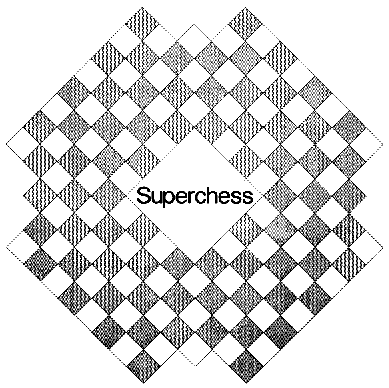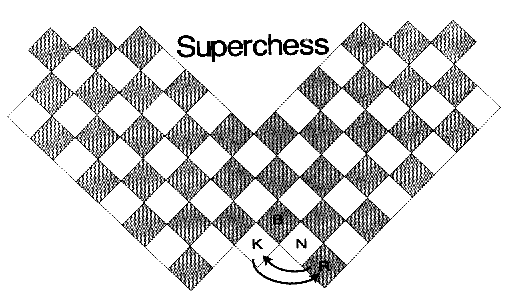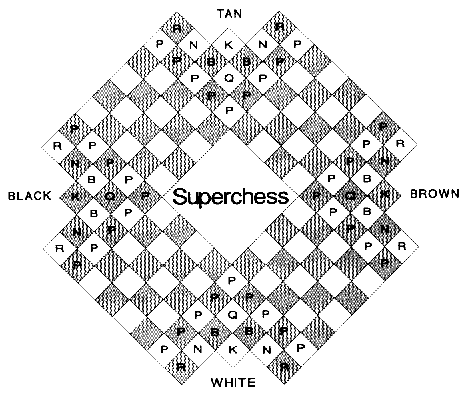Superchess
Official Rules and Game Description
Note: Superchess was invented by Rolf W. Jacobson, and is (or was) a game distributed by Green Island Games. Having made reasonable efforts to contact them, we can only assume they have gone out of business. However this may not necessarily be true, so if anyone knows of how we could contact this company, please let us know so we can request permission to continue publishing these rules. Thank you.Introduction:
Superchess is a variation of standard chess. If you know how to play chess you can easily learn to play Superchess.
The primary difference between chess and Superchess is the Superchess board as shown below:

Superchess is a form of "double chess" or "four-handed chess." There are four "armies" of chess pieces. Two, three or four players can participate because of this feature. The array of chess pieces for the beginning of the game is shown on Diagram 2:
Diagram 2

K = King
Q = Queen
R = Rook
B = Bishop
N = Knight
P = Pawn
As you can see, the chessmen used in Superchess are the same as in orthodox chess. The individual chess pieces move and capture just as they do in standard chess. The arrows on Diagram 3 help clarify.
Diagram 3

The "center zone" (the area in the middle of the board without checkered squares) is not a play area. Pieces cannot cross over the center zone except for Knights moving over corners.
The object of the game is the same as in regular chess: to checkmate the opposing King; or in the case of Superchess, the opposing Kings.
Regardless of your chess playing ability, you will find Superchess to be a very engaging chess variant. This is because the Superchess board, with its squares shifted at 45 degrees, requires the opposing forces to play one another head to head, something lacking in other forms of four way chess.
Early in the game, battles between the chess pieces are primarily fought on four "frontiers" rather than just one. Later in the match, after pieces have been exchanged and the board begins to open up, powerful cross-board moves begin to occur. Dramatic moves of Queens, Rooks, and Bishops during endgame play makes for exciting finales.
Types of Play
2-Person Play:
One person controls the light-colored forces, the other player controls the dark-colored forces. Play proceeds in an alternating order (light, dark, light ). On a given turn, a player may move any of his pieces provided the move is legal.
4-Person Play
Teams of two players each vie for Superchess victory. One team controls the light-colored forces, the other team controls the dark-colored forces. Partners sit across from each other. Each player controls one quadrant or army and may only move their armys pieces on their turn. The order of play proceeds clockwise around the board.
3-Person Play
On player controls two armies of chessmen against a team of two players who work together as partners. Each member of the two-player team controls one army of pieces. As in the 4-person game, the order of play proceeds clockwise around the board one color at a time.
Primary Rules
All of the orthodox rules of chess apply unless otherwise noted herein.
Opening Array and Piece Movement:
To begin the game, place the pieces in the opening game array shown below in
Diagram 4.
Diagram 4

The player controlling the "South Quadrant" (white pieces) makes the first move of the game.
Pawn Movement:
A pawn may advance either one or two squares the first time it moves. On subsequent moves, the pawn may advance one square forward. Pawns capture other pieces with a forward diagonal move. Pawns can only move and capture toward the opposing forces immediately opposite them unless they are "point pawns."
"Point pawns" are located at the corners of the "center zone" when play begins. Unlike other pawns, point pawns have the option of moving towards either enemy array from the beginning position. Once a point pawn moves (or makes a capture) in one direction, it is committed to continue in that direction. Pawns cannot reverse course. Pawns circled in the diagram below are the point pawns.
Diagram 5

Pawn Promotion:
Once a pawn has moved to the other side of the board where it can no longer move forward, it is promoted and may become a Queeen.
Capturing:
Captures are carried out as in standard chess. Captured pieces are removed from the board. You may not capture your own pieces or your partners pieces.
Castling:
To carry out the castling move, simply exchange the location of your King with a Rook in the same quadrant. You may not castle if you are in check, or if castling would put you in check, or if your King or Rook have already moved.
Diagram 6

As shown in the above diagram, the Knight and Bishop need not be moved prior to castling. If adjacent squares (e.g. the Bishop and Knight squares shown above) are threatened by an opposing piece you may still castle.
Check:
Whenever you move one of your pieces so your opponents King is in the line of attack, the King in check. It is customary to announce this to your opponent by saying "check." If your King is in check it must be taken out of check on your next move. This can be accomplished by moving the King out of check, blocking the line of attack with another piece, or capturing the piece which is checking the King. You may not move your King into check or move a piece that would put yourself or your partner in check. If your partners King is put in check, you are obliged-but not required-to alleviate the check on your move.
Checkmate:
If a King is in check and cannot be freed by a move, block, or capture, the King is "checkmated." Once checkmated, the King must be removed from the board by the checkmated player on his turn; no other pieces may be removed. Removing the checkmated King count as a move. Pieces of the same color as the checkmated King remain on the board and continue to be played by the same player.
For example, if the brown King is checkmated, the player controlling the brown army moves the King off the board on his turn. On subsequent turns, he continues to play the brown pieces which remain on the board. These remaining brown pieces have allegiance to the black King, the fallen brown Kings brother.
Resignation Rule:
Should a player decide to resign a King it shall be counted as a move. To resign, the player announces during his turn that he is resigning and moves the resigned King off the board; no other pieces may be moved. Following the resignation, play proceeds by having the next player take his turn. Pieces of the same color as the resigned King remain on the board and continue to be played by the same player.
Object of the Game:
To win you must be the first to achieve two checkmates. For example, in order for the dark-forces to win, they must checkmate, or force the resignations of both light-colored Kings.
More on Pawn Promotion:
Once a pawn has moved to the other side of the board where it can no longer move forward, it is promoted and becomes any piece except a King.
Alternatively, if a pawn makes a capture which results in the pawn entering a new frontier, the pawn makes a capture which results in the pawn entering a new frontier, the pawn is promoted. A "frontier" is any playing area not covered by pieces at the beginning of the game. Please see Diagram 7 on the following diagram for clarification.
Diagram 7

In the above diagram, the shaded squares show where pawn promotion would occur for a south quadrant pawn which is moving towards the west quadrant. For example, a pawn which began in the south quadrant is promoted once it reaches the end of a file of a squares. If a pawn makes a capture and enters the northwest frontier it is also promoted.
Players may promote their pawns into pieces for their partners. For example, a promoted black pawn could become a brown Queen.
Stalemates and Passing Turns:
A player is "stalemated" when it is his turn, his King is not in check and he cannot make a legal move. In 2-person play a draw is declared once a player is stalemated. In 3 and 4-person play, the stalemated player must either pass or resign on his turn. If the stalemated player who passes on his turn(s) can be freed from the stalemate at any time by his partner, he may continue to play.
Similarly, if all of a quadrants pieces have been removed from the board in 3 or 4-person play, the player must pass on his turn since he has no legal move. (If a player has a legal move he may not pass.)
Draws:
A draw occurs when all players agree to a draw; when a player is stalemated in 2-person play; when both quadrants of a team are stalemated in 3-person or 4-person play; or when neither side can checkmate both opposing Kings.
Double Check:
"Double check" occurs when a move puts both opposing Kings in check. Double check may result in one, two or no checkmates depending on the subsequent moves.
For example, when double check occurs in 2-person play, it results in at least one checkmate unless the threatening piece can be captured. This is because even if one King can be removed from the board on the same turn, the other cannot and is therefore checkmated and removed from the board on the same turn. This may or may not be the case in 3 or 4-person play since the checkmated team would have two moves to alleviate the double check.
Communication Between Partners:
Restricting "Table talk" tends to add a welcome strategic twist to the game. Not restricting it tends to lead to endless tripe on who should move where. There is no communication between players at all in tournament play.
Alternative Array:

Invented by . Web page posted by David Howe.
WWW page created: 10 Dec 2000. Last modified on: 10 Dec 2000.
